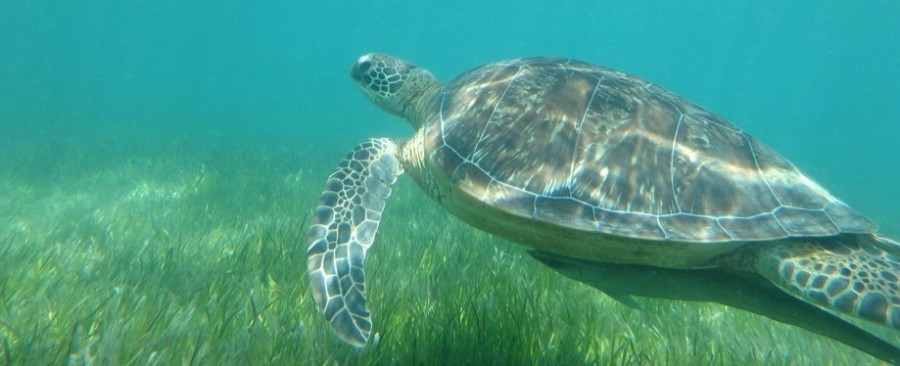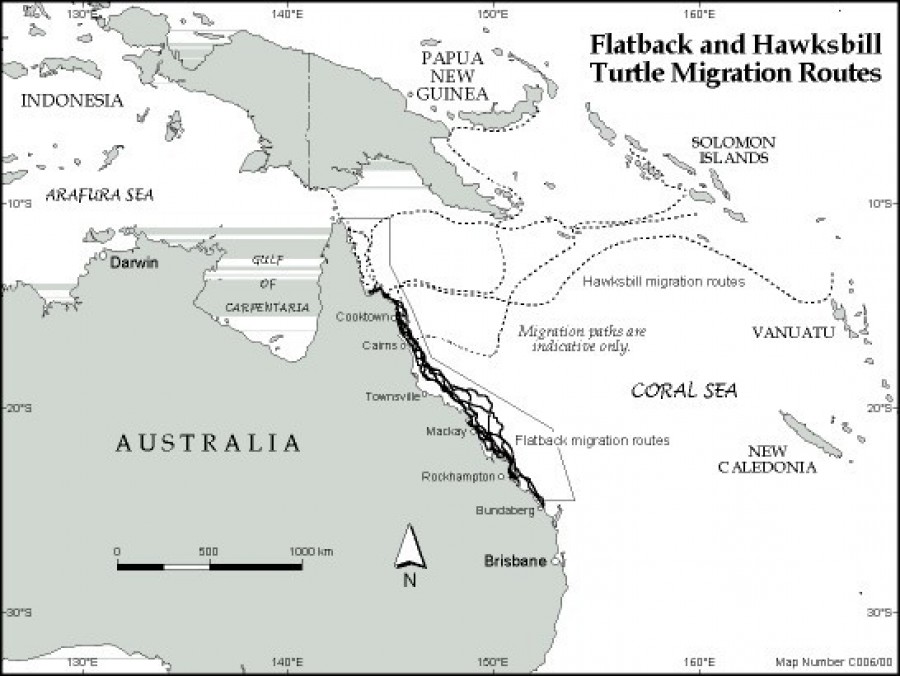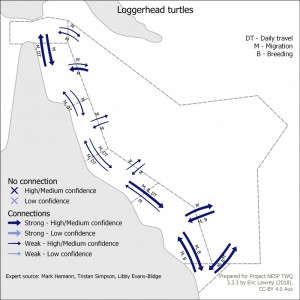Marine turtle connectivity
Introduction to marine turtles and why they are important
Marine turtles are an important part of marine ecosystems and arose from ancient species that existed in the Jurassic period. Six species of marine turtles have been recorded in the northeast Australian seascape and four species breed in the region. All six species are listed as threatened under the Australian Environment Protection and Biodiversity Conservation (EPBC) Act 1999. The high connectivity of marine turtles exposes them to many threats and pressures throughout their range. The recent Australian Government Marine Turtle Recovery Plan (Commonwealth of Australia 2017) lists existing known pressures, and assigns a level of risk for each turtle species in Australia. Very high risks include climate variability and change, ingestion and entanglement in marine debris, pollution, fisheries (including direct take and as by-catch) and predation of eggs.
Australia is a signatory to a number of international conventions and agreements to protect marine turtles, including: the Convention on International Trade of Endangered Species of Wild Fauna and Flora (CITES), the Convention on the Conservation of Migratory Species of Wild Animals (CMS), and the Memorandum of Understanding on the Conservation and Management of Marine Turtles and their Habitats of the Indian Ocean and South-East Asia (IOSEA Marine Turtle MOU). These international conservation instruments are focus on aiding and facilitating international support for the conservation of migratory species, such as marine turtles.
Key concepts that relate to connectivity
All marine turtle species are migratory and tracking data shows the movement of the six species across the northeast Australian seascape. In addition, research on population genetics indicates that foraging aggregations of a single species can be comprised of turtles from more than one population (e.g. Benson et al. 2011, Boyle et al. 2008, Limpus 2009a, Dethmers et al. 2011, Miller et al. 1998, Read et al. 2014).
Marine turtles in Australasia congregate around genetically distinct breeding sites, and individuals disperse or migrate to form mixed-stock foraging areas. For example, there are three genetically distinct stocks of green turtles breeding in eastern Australia arising from breeding sites in the northern GBR and eastern Torres Strait (e.g. Raine Island – GBR and Maizub Kaur in TS), southern GBR (e.g. Heron Island) and the Coral Sea plateau (e.g. Herald Cays). While nesting turtles for each stock aggregate in their respective areas for nesting, individuals from these stocks are dispersed throughout the south-western Pacific Ocean and into the Gulf of Carpentaria (Limpus 2009a,b,c,d, Read et al. 2014, Commonwealth of Australia 2017) (e.g. see Figure 2).
In addition to the connectivity between the four regions, it is likely that marine turtles residing in south-eastern Australia (NSW, Victoria and Tasmania) breed in northeast Australia or migrate through the region towards international rookeries in New Caledonia, Solomon Islands, PNG or the Arafura Sea (Read et al. 2014, Commonwealth of Australia 2017). Some data indicate that some green, flatback and hawksbill turtles residing in the Gulf of Carpentaria migrate to breeding sites in Torres Strait and the GBR (Limpus 2009b,c,d) (see Figures 2 and 3).
Loggerhead turtles (Caretta caretta) have a single population that breeds in New Caledonia, the GBR and Great Sandy Strait. Migrations have been recorded between breeding sites in the southern GBR and Woongarra Coast (Bundaberg region) and foraging sites in Great Sandy Strait, GBR, Coral Sea (New Caledonia) and Torres Strait. Individual turtles breeding in New Caledonia have been recorded in the GBR. Individuals from this population live in, and migrate through, all four marine domains (Figure 3).
Flatback turtles (Natator depressus) have two genetically distinct populations, one breeding in Torres Strait and the other breeding in the GBR. Individuals from the Torres Strait population likely live in, and migrate through, the Torres Strait and the GBR. Individuals from the GBR population likely live in, and migrate through, the GBR, Torres Strait and Great Sandy Strait (Figures 2 and 3).
References
Benson, S. R., Eguchi, T., Foley, D. G., Forney, K. A., Bailey, H., Hitipeuw, C., et al. (2011) Large-scale movements and high-use areas of western Pacific leatherback turtles, Dermochelys coriacea. Ecosphere, 2(7), 1-27.
Boyle, M.C., FitzSimmons, N.N., Limpus, C.J., Kelez, S., Velez-Zuazo, X., Waycott, M. (2009) Evidence for transoceanic migrations by loggerhead sea turtles in the southern Pacific Ocean. Proceedings of the Royal Society of London B: Biological Sciences.
Commonwealth of Australia (2017) Recovery plan for marine turtles in Australia. Commonwealth of Australia. 154 pages.
Convention on Migratory Species (2014) Single species action plan for the loggerhead turtle in the south Pacific Ocean. Convention on Migratory Species UNEP/CMS/COP11/Doc23.2.2
Dethmers, K.E., Jensen, M.P., FitzSimmons, N.N., Broderick, D., Limpus, C.J. and Moritz, C., 2011. Migration of green turtles (Chelonia mydas) from Australasian feeding grounds inferred from genetic analyses. Marine and Freshwater Research, 61(12), pp.1376-1387.
Limpus, C.J (2009a) A biological review of Australian marine turtles – 1. loggerhead turtle, Caretta caretta (Linnaeus). Queensland Environmental Protection Agency, 55pp.
Limpus, C.J (2009b) A biological review of Australian marine turtles – 2. green turtle, Chelonia mydas (Linnaeus). Queensland Environmental Protection Agency, 81pp.
Limpus, C.J (2009c) A biological review of Australian marine turtles – 3. Hawksbill turtle, Eretmochelys imbricata (Linnaeus). Queensland Environmental Protection Agency, 45pp.
Limpus, C.J (2009d) A biological review of Australian marine turtles – 4. Flatback turtle, Natator depressus (Linnaeus). Queensland Environmental Protection Agency, 45pp.
Miller, J.D., Dobbs, K.A., Limpus, C.J., Mattocks, N., Landry Jr, A.M. (1998) Long-distance migrations by the hawksbill turtle, Eretmochelys imbricata, from north-eastern Australia. Wildlife Research, 25(1), 89-95.
Read, T.C., Wantiez, L., Werry, J.M., Farman, R., Petro, G., Limpus, C.J. (2014) Migrations of green turtles (Chelonia mydas) between nesting and foraging grounds across the Coral Sea. PloS One, 9(6), e100083.









